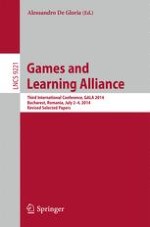2015 | OriginalPaper | Chapter
Improved Multimodal Emotion Recognition for Better Game-Based Learning
Authors : Kiavash Bahreini, Rob Nadolski, Wim Westera
Published in: Games and Learning Alliance
Publisher: Springer International Publishing
Activate our intelligent search to find suitable subject content or patents.
Select sections of text to find matching patents with Artificial Intelligence. powered by
Select sections of text to find additional relevant content using AI-assisted search. powered by
